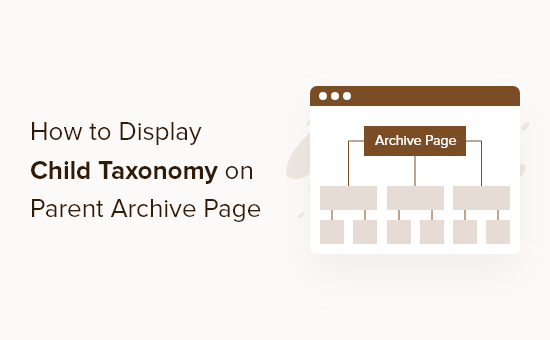Do you want to learn how to display a child taxonomy on a parent taxonomy archive page?
You may need to do this when customizing your taxonomy archive page to make it more useful to your visitors.
In this article, we will show you how you can easily show your child taxonomies on your parent taxonomy archive page.

Why Display a Child Taxonomy on the Parent Taxonomy Archive Page?
By displaying all of your child taxonomies on the parent taxonomy archive page, you can make it less generic and more useful to your visitors.
For example, if you run a WordPress blog about books and have a taxonomy called ‘Subjects’, then you can add child taxonomies like ‘Fiction’, ‘Non-Fiction’, and more, so your readers can easily sort through your books.
When you have a lot of content, this not only makes it easier to stay organized but helps your visitors find related content faster.
For more details on using taxonomies, see our guide on how to create custom taxonomies in WordPress.
That being said, let’s show you how to display child taxonomies on parent taxonomy archive pages.
Displaying Child Taxonomies on Parent Taxonomy Archive Page
This tutorial requires some basic understanding of how to add code to WordPress. For more details, see our beginner’s guide to pasting snippets from the web into WordPress.
Then, you will need to find your WordPress theme’s taxonomy template file. It will usually be named something like taxonomy-{taxonomyname}.php.
If you’ve created a custom taxonomy called ‘books’, then the name would be taxonomy-books.php. If you don’t have this file, then you will need to create it first.
To learn more, see our WordPress template hierarchy cheat sheet to help find the taxonomy theme template file that you need to edit.
Once you have found the right taxonomy template file, you can simply add the following code to where you want to display the list:
<?php
$term = get_term_by( 'slug', get_query_var( 'term' ), get_query_var( 'taxonomy' ) );
if ($term->parent == 0) {
$args = array(
'taxonomy' => 'subject',
'depth' => 1,
'show_count' => 0,
'title_li' => '',
'child_of' => $term->term_id
);
wp_list_categories($args);
} else {
$args = array(
'taxonomy' => 'subject',
'depth' => 1,
'show_count' => 0,
'title_li' => '',
'child_of' => $term->parent
);
wp_list_categories($args);
}
?>
You need to replace the taxonomy subject with the name of your taxonomy.
This code will identify the current parent taxonomy based on the post ‘slug’, then it will display any of the child taxonomies that are related to that term.
Here is how the child taxonomy list will look to your visitors.

Notice how it simply lists all of the child taxonomies of the single parent taxonomy. In this case, it shows the different book subjects present in our parent taxonomy.
For more details on customizing your taxonomy page, see our guide on how to show the current taxonomy title, URL, and more in WordPress.
Expert Guides on Custom Taxonomies in WordPress
Now that you know how to display a child taxonomy on a parent taxonomy archive page, you may like to see some other guides related to custom taxonomies:
- When Do You Need a Custom Post Type or Taxonomy in WordPress?
- How to Create Custom Taxonomies in WordPress
- How to Convert WordPress Categories to Custom Taxonomies
- How to Show the Current Taxonomy Title, URL, & More in WordPress
- How to Add Taxonomy Images (Category Icons) in WordPress
- How to Add Custom Meta Fields to Custom Taxonomies in WordPress
- How to Add Categories to a Custom Post Type in WordPress
- How to Display Custom Taxonomy Terms in WordPress Sidebar Widgets
- How to Add Ajax Taxonomies Filter in WordPress Search
We hope this article helped you learn how to display a child taxonomy on the parent taxonomy archive page. You may also want to see our guide on the difference between a domain name and web hosting and our expert picks of the best GoDaddy alternatives.
If you liked this article, then please subscribe to our YouTube Channel for WordPress video tutorials. You can also find us on Twitter and Facebook.





Syed Balkhi says
Hey WPBeginner readers,
Did you know you can win exciting prizes by commenting on WPBeginner?
Every month, our top blog commenters will win HUGE rewards, including premium WordPress plugin licenses and cash prizes.
You can get more details about the contest from here.
Start sharing your thoughts below to stand a chance to win!
Zulya says
Hello. Thank you for the code. It works.
But I have a question. How can I hide “title” when hovering the custom taxonomy links. At the moment, the description of each custom taxonomy is displayed in hovering title. Thank you.
Susan Clifton says
I’m using the plugin Taxonomy Images so I would like to include that thumbnail in this list. This is my structure:
Custom post type= Artwork
hierarchical taxonomy= Artist Name
I’m looking for each artist name to up with the thumbnail as a grid list to view artwork.
I created a taxonomy template for the single artist page, no problem but can’t figure out how to do a list of artists. This solution almost works for me. But I’m getting each artist multiple times in this list.
Hint…Hint
Editorial Staff says
Hey Susan,
Not sure why you are getting each artist multiple times. As for Taxonomy Images, Michael Fields have a bunch of queries on the plugins page.
Admin
Jake says
Almost exactly what I was looking for. I however have one problem: when my Taxonomy has no children I get a single list item that says “No Categories”. What should I do to just display nothing if there are no children?
Much appreciated!
James says
Had been googling for a while for a solution like this. Cheers
Rasha says
Can it show thumbnail also for child terms ??
Thanks
Rottenpeach_com says
@syedbalkhi I confused Taxonomy with Taxidermy…#TheAwkwardMoment
syedbalkhi says
@rottenpeach_com lol